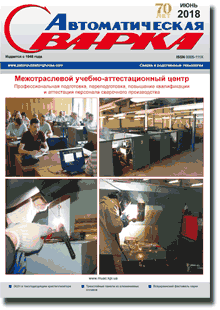| 2018 №06 (02) |
DOI of Article 10.15407/as2018.06.03 |
2018 №06 (04) |

Avtomaticheskaya Svarka (Automatic Welding), # 6, 2018, pp. 24-32
Influence of process and electrical parameters of ESS in current-supplying mould on electrode melting rate and penetration of base metal
V. G. Solovjev, Yu. M. Kuskov
E. O. Paton Electric Welding Institute of the NAS of Ukraine. 11 Kazimir Malevich Str., 03150, Kyiv, Ukraine. E-mail: office@paton.kiev.ua
A computational experiment was conducted which showed that the controlled electrical parameters of the process can be used to regulate the shape of the metal pool and electrode melting rate. Dependencies between the depth of electrode immersion into the slag pool, average depth of item penetration and uniformity of item penetration relative to average penetration depth were determined. A method was proposed for computation of the depth of electrode immersion into the slag pool by the ratio of currents in CSM. Comparative analysis of the three types of single-loop circuits of the mould connection to the power source was performed, and an optimum circuit for the required criteria of surfacing quality was proposed. 8 Ref., 1 Tabl., 12 Fig.
Keywords: current-supplying mould, experiment, automation, metal pool, regulation, penetration, bottom plate, electrode, conductivity, power circuit
Received: 30.03.2018
Published: 29.05.2018
References
- Troyansky, A.A., Ryabtsev, A.D., Samborsky, M.V., Mastepan, V.Yu. (2002) Application of measuring information system for investigation of ESR process. Metall i Litio Ukrainu, 7-8, 25-26 [in Russian].
- Troyansky, A.A., Ryabtsev, A.D., Mastepan, V.Yu. (2004) Indirect methods for control of ESR technological parameters based on application of harmonic composition of current and voltage of remelting. In: of Papers of Int. Scient. Conf. on Modern Problems of Theory and Practice of Quality Steel Production (Mariupol, 8-10 September 2004). Priazov. STU, pp. 80-82 [in Russian].
- Troyansky, A.A., Ryabtsev, A.D., Mastepan, V.Yu. et al. (2005) Application of method of current distribution modeling as the base for development of technology of high-quality ingots by CESR method. Metallurg. Protsessy i Oborudovanie, 2, 25-27 [in Russian].
- Makhnenko, V.I., Demchenko, V.F., Tarasevich, N.I., Krikent, I.V. (1985) Calculation system for investigation of current distribution in slag pool. Problemy Spets. Elektrometallurgii, 1, 14-19 [in Russian].
- Tomilenko, S.V., Kuskov, Yu.M. (2000) Regulation and stabilization of base metal depth penetration in electroslag surfacing in current-supplying mold. Proizvodstro, 9, 32-35[in Russian].
- Tomilenko, S.V., Kuskov, Yu.M. (1999) Power features of electroslag process in current-supplying mold. Svarka, 2, 51-53[in Russian].
- Shmelev, V.E. Partial differential equations toolbox. Toolbox for solution of differential equations in partial derivatives [in Russian]. http://matlab.exponenta.ru/pde/book1/index.php
- Govorkov, V.A. (1968) Electric and magnetic fields. 3rd Ed. Moscow, Energiya [in Russian].
